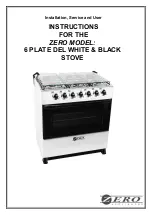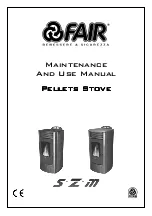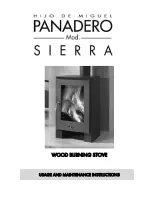
-14-
1.
If the stove is still warm, it will resume feeding fuel and continue to operate normally. If the fire has gone out,
you will have to press the “OFF” button and then the “ON” button again to begin a new start-up sequence.
2. If the stove has cooled-off, it will reset to its “OFF” condition. At this point, you may press the “ON” button and
the unit will begin a new start-up sequence.
NOTE: The unit will also shut down in the event of an exhaust blower failure; if this is the case, the unit will not re-
start and you must contact Customer Service at (800) 750-2723.
SAFETY AND CONVENIENCE FEATURES
Your pellet stove incorporates a safety pressure switch that helps ensure that everything is in proper working
order before feeding fuel to the burn pot. Because the stove works using an induced draft pressure, the stove
will not continue to operate if the viewing door is left open; or if the exhaust blower fails or the exhaust system is
blocked.
The temperature limit control (Thermistor) will prevent your stove from operating at abnormally high temperatures.
Should the stove temperature begin to approach the factory pre-set limit, the temperature limit control will
automatically slow down the auger feed rate until the temperature returns to a normal condition. Even though
the heater will operate on the highest setting, we recommend to operate your heater on this setting for only a
short period of time. (1 hour etc.)
Your pellet stove also includes an auto-start igniter as a standard feature. The use of other fire starter materials
(wood chips, starter gel, etc.) is not necessary. By simply pressing the “ON” button on the digital control panel,
your stove will begin to feed fuel and automatically start within 5 minutes.
TAMPER WARNING
This wood heater has a manufacturer-set minimum low burn rate that must not be altered. It is against federal
regulations to alter this setting or otherwise operate this wood heater in a manner inconsistent with operating
instructions in this manual.
• Failure to clean and maintain this unit as indicated can result in poor performance and safety hazards.
•
Unplug your stove’s electrical cord prior to removing the back panel or opening the exhaust system for any
inspection, cleaning, or maintenance work.
• Never perform any inspections, cleaning, or maintenance on a hot stove.
•
Do not operate stove with broken glass , leakage of flue gas may result.
•
WARNING: The chimney and chimney connector must be kept in good condition and clean.
EXHAUST SYSTEM
Creosote Formation – When any wood is burned slowly, it produces tar and other organic vapors, which combine
with expelled moisture to form creosote. The creosote vapors condense in the relatively cool chimney flue or a
newly started fire or from a slow-burning fire. As a result, creosote residue accumulates on the flue lining. When
ignited, this creosote makes an extremely hot fire, which may damage the chimney or even destroy the house.
Despite their high efficiency, pellet stoves can accumulate creosote under certain conditions.
Fly Ash – This accumulates in the horizontal portion of an exhaust run. Though non-combustible, it may impede
the normal exhaust flow. It should therefore be periodically removed.
Inspection and Removal – The chimney connector and chimney should be inspected annually or per ton to
determine if a creosote or fly ash build-up has occurred. If creosote has accumulated, it should be removed to
reduce the risk of a chimney fire. Inspect the system at the stove connection and at the chimney top. Cooler
surfaces tend to build creosote deposits quicker, so it is important to check the chimney from the top as well as
from the bottom. The creosote should be removed with a brush specifically designed for the type of chimney
in use. A qualified chimney sweep can perform this service. It is also recommended that before each heating
season the entire system be professionally inspected, cleaned and, if necessary, repaired. To clean the chimney,
disconnect the vent from the stove.
INTERIOR CHAMBERS
Periodically remove and clean the burnpot and the area inside the burnpot housing. In particular it is advisable
to clean out the holes in the burnpot to remove any build up that may prevent air from moving through the burn
pot freely. Remove the two(2) plates on each side of the burnpot housing and clean out that rear chamber.
If a vacuum is used to clean your stove, we suggest using a vacuum designed for ash removal. Some regular
vacuum cleaner (i.e. shop vacs) may leak ash into the room.
Maintenance
Содержание KP130
Страница 2: ......
Страница 22: ...20 9 3 2 1 5 6 4 7 8 10 Parts Diagram 47 46 48 49 50...
Страница 27: ...20 Sch ma des pi ces 9 3 2 1 5 6 4 7 8 10 47 46 48 49 50...
















































